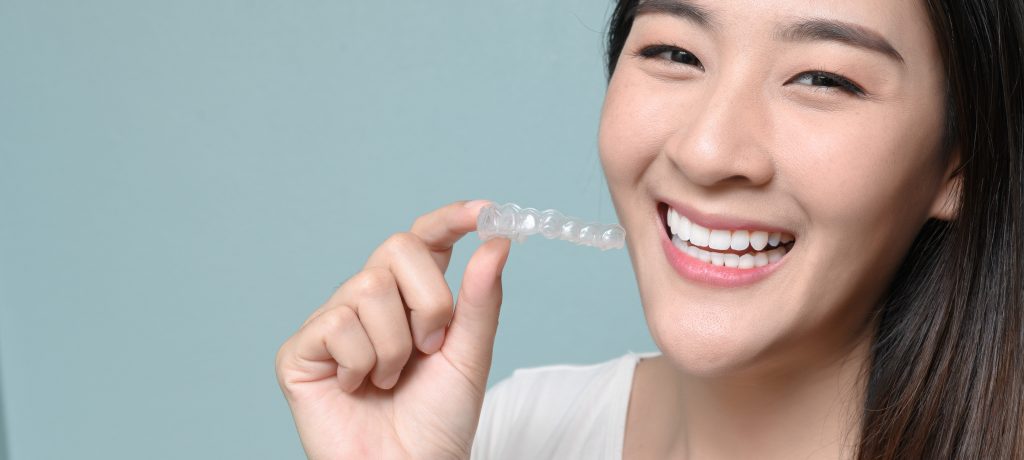Resource Library
Start Reading


Do you or your budding teenager have crooked teeth or a misaligned bite? If so, you’re probably weighing the options of traditional orthodontics vs. clear aligners. The big advantage of using clear aligners is their aesthetic appeal. Dental aligners are barely noticeable on the teeth, making for an unobtrusive orthodontic treatment. But what else should you know about this option?
We recently sat down to discuss this with Dr. Wulc, the lead orthodontist on staff at Penn Dental Family Practice. Check out our Q&A below to learn how clear aligners work, how to know whether they’re right for you, and more!
Q: In your mind, what are the principal advantages of clear aligners?
As you’ll often hear, clear aligners are the aesthetically pleasing option. They’re a great choice for people who don’t want the whole world noticing that they’ve started orthodontic treatment. They’re great for adults and professionals who are wary of pursuing braces because of associations with the “old school” stereotype.
Another advantage is that they’re more conducive to oral hygiene. Using clear orthodontic aligners decreases your risk of developing cavities compared to braces. That’s because you can take the aligners out to thoroughly clean your teeth each day, whereas normal braces involve more hardware that can get in the way as you’re brushing.
Q: As far as day-to-day, what are you committing to when you select this treatment?
The recommendation is for 22 hours of wear per day, which includes the time you sleep with them on. You do have the freedom to remove them occasionally, like for big events. With braces, we have to give patients a list of foods they can’t eat during treatment because they may break the brackets. But because aligners can be taken out when you’re eating and brushing your teeth, you can go ahead and eat that corn on the cob!
Q: What indications do you look for that make clear aligners the right choice for a patient?
There have been great advances in technology and research in regards to clear aligners. There are numerous indications for clear aligner treatment and as this technology improves, I find less cases requiring traditional braces. However, there are still some cases that are so complex that they still need braces and possibly surgery. I think that aligner technology is catching up to be able to meet these needs. Others may tell you that they’re equally effective or that clear aligners have a long way to go. But in my experience, it’s only in severe cases that we still have to use traditional braces.
Q: Aside from straightening, are there other orthodontic conditions that can be treated by clear aligners?
Clear aligners can be used as an adjunct to support other dental procedures in some cases. For example, if you are missing a tooth and don’t have enough space to add an implant, clear aligners could open up that space. As an added bonus, clear aligners can provide protection for patients who grind their teeth. However, the main function is to move the teeth into proper position, eliminating crooked teeth and bite issues.
Q: In terms of time, how long does it take for clear teeth aligners to work when compared to the traditional bracket system?
It depends. In some cases, clear aligners can be much faster. You might see commercials saying that it will take three, six, or nine months, but that is mainly in the case of crooked or rotated teeth. Clear aligners work quickly for that type of issue, but bite correction tends to take longer periods. I rarely see aligners take significantly longer than traditional braces, but generally, they usually take about the same or a shorter amount of time.
Q: You’ve been using teledentistry more, ever since the early days of COVID-19. Has that become more important, and maybe a facilitator for your patients?
Oh, yes. I have to give credit to Dr. Singer, who has worked with Dean Wolff to put together protocols that allow us to practice within this “new normal.”
We now have virtual consultations in which we meet with patients and evaluate them. The advantage of clear aligners vs. braces is that a lot of the contact required for braces isn’t as necessary for aligners. Once a patient comes in for a scan to begin treatment, I can ship them their trays and perform my treatment supervision remotely and avoid bringing the patient into the office as frequently as the braces patients.
For patients who do need to come in for treatment, PDFP is the gold standard for PPE and the protection of patients and staff. We are outfitted to the T and because of this, we feel we can provide care safely to patients. We also have options for patients who have specific health conditions who can’t make it into the practice; we can see them virtually in a way we couldn’t before.
Q: Are there considerations that are different depending on whether the patient is an adolescent or adult? What are the differences there?
Anytime a teenager interested in clear aligners comes in, I always look them in the eye and have a “serious” talk with them. I tell them, “in addition to homework, school, friends, and everything you have going on, you’re going to have to remember to switch your clear aligners every two weeks, wear it for 22 hours daily, and not let the dog get to it.” At that point, you can see the patient’s eyes widen as they realize what will be required on their end in terms of additional responsibility. So a big part of treatment depends upon compliance with the rules. Sometimes, after this “talk” a teenager will look at me and start laughing and say “there’s no way I can do that.” Compliance is a factor that tends to separate teens from adults because of the level of discipline required. If we’re not sure, we’ll tend to steer them towards the traditional brackets.
However, I do have a fair share of adolescent patients that are so motivated to avoid the traditional braces route that they become excellent clear aligner patients and have tremendous success with their treatment.
Q: What does the entire course of treatment look like with clear aligners?
The first step is a consultation appointment. At that appointment, I’ll tell them whether or not they’re a candidate for treatment. We will discuss what would be involved for treatment––wearing trays 22 hours per day, plus the nitty-gritty of what their specific treatment will involve. Then if they choose to proceed, we process the financial aspect with their insurance.
The next “records” appointment involves taking the pictures, x-rays, and scans needed to fabricate the trays for the patient.
After that, a set of trays are printed out. The aligner provider might send 10, 20, 30, or even 40 trays. Each tray involves half a millimeter of movement. You progress through the series of trays to get the end result, kind of like a flipbook; it’s a gradual movement through a series of trays.
Then, I have a conversation with the patient about what their daily routine and schedule looks like. The idea is to accommodate checkups to their daily schedule. Some patients may want to come in every six to eight weeks, whereas others may need less frequent visits.
After they’ve gone through all their trays, the patient starts with retainers. Retainers are just as important as the treatment because even after all the treatment, the teeth have a tendency to shift back. So we recommend that patients wear the retainers at night indefinitely. Maintenance is a very important part of treatment success.
Q: What would you want patients to know to get them to start thinking about clear aligners if they hadn’t considered this treatment option before?
Lots of patients are surprised to hear that they are candidates for clear aligners. The general perception is that clear aligners only work for minor orthodontic problems. But who is and is not a candidate may surprise you. If you’re thinking about it and you’re not sure, just come in for a consultation. The worst thing we can say is that you’re not a candidate. But many people are surprised that it’s an option for them, and it’s a treatment that’s much more amenable to their lives than the traditional route.
Q: Did you ever have a patient who represents an unusual case—maybe an older patient who decided that they finally want to do this for themselves?
I do have many older patients pursuing clear aligner treatments! I recently finished caring for a patient who was in his late seventies. All of his kids and grandkids had gone through treatment; then it was finally grandad’s turn. You know, it’s always the parents that go last. We always take care of our kids first before taking care of ourselves! So both for him and for me, it was very rewarding to go through the process. After 75 years, it has finally given him the smile that he deserves!
Would you like to know if you are a candidate for clear orthodontic aligners? Request your free consultation online or by calling 215-898-7337!